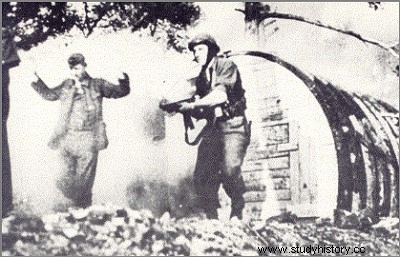
The period preceding the landing saw an upsurge in raids and espionage activities by the 500 maquisards of the French Forces of the Interior (F.F.I.).
However, the Germans remained a surprising indecision, not knowing how to predict the site chosen for the landing. Genoa, the Adriatic, a double attack on Nice-Cannes and Marseille-Toulon were put forward as possibilities. The confusion was fueled by clever diversions, including a raid on La Ciotat, near Marseille, in which five R.A.F. dropped a deluge of 300 miniature models that simulated firing when they hit the ground. This ruse convinced the Germans to expect a regular attack on Marseilles by 500 troop transports.
Confusion still reigned among the Germans when the Allied armada set out to the landing beaches. On August 14, a Luftwaffe aerial reconnaissance sighted the fleet heading north, thus pretending to reach Genoa. The planes returned to their base carrying their fake news. At 10:18 p.m., Vice-Admiral Hewitt ordered a 60° turn to port. The Allied fleet headed
north-west and headed for southern France. By midnight, she was in position about twenty kilometers from the coast.
As the main assault force awaited its scheduled time to go into action, 8:00 a.m. the next morning, French commandos crept in from either side of the main landing area, at Cap Nègre, above Cavalaire-sur-Mer and near the Esterel cliffs, west of Cannes. At the same time, the Americans and Canadians of the 1st Special Units Corps were preparing to set foot on Levant Island and Port-Cros, in the Hyères Islands group.
These different sites represented threats to the security and success of the next day's landings. Cap Nègre, for example, was a 120 meter cliff surmounted by 3 150 mm guns and a battery of electrically operated flamethrowers. Cap Nègre and the two islands were captured as planned, although Port-Cros did not surrender until 17 August. The Esterel cliffs were the scene of a tragic fiasco, when 42 of the 67 French commandos found themselves on a minefield buried on the beach. The 25 survivors, after having failed in their attempt to plant their explosives on the nearby road from Cannes to Saint-Raphaël, were captured by the Germans. This failure left the road leading to a particularly sensitive sector of the Allied landing zone open to German reinforcements on the day of the invasion.
The night before Operation "Dragoon" saw massive airdrops operation "Rugby", in addition to commando attacks by sea. These parachute drops took place in an area of fields and wooded hills
40 square kilometers near Le Muy, not Draguignan. More than 5,000 American, British and French infantry, gunners and engineers of the 1st Airborne Task Force, under the command of Major General Robert T. Frederick, were transported from Rome in 396 C-47 Dakotas and C-53 At 4:22 a.m., the last man had jumped.
When the paratroopers touched down, there was a thick mist, some of them found themselves 35 kilometers from the intended location They met only sporadic resistance in the vicinity of Le Muy and were able to set up their roadblocks, their machine-gun nests in relative peace and prepare the ground for the landings the following day at 8 o'clock. Before the end of the day on August 15, more than 400 Waco and Horsa gliders, towed by C-47 Dakotas, were to land near Le Muy with 4,000 additional fighters and heavy weapons.
That same day, the colossal air force assigned to the o The "Dragoon" operation carried out 4,249 other missions, including 4,000 intended to cover the landing. The Luftwaffe was only able to fly 60 missions, all of them ineffective.
Allied air activity began on August 15 with a 90-minute shelling of the coastal defenses. A few seconds after these bombardments, at 7:30 a.m., the 400 guns of the warships went into action, pouring a deluge of shells on the beaches and the hinterland.
The Germans were eerily silent until 7:47 a.m., when their Cavalaire and La Mole batteries, located 3 kilometers inland, began to fire back. However, these guns made only a pitiful response to the downpour of fire from the sea. When the naval artillery barrage ended at 7:49 a.m., the ships had fired 16,000 shells in 19 minutes of firing. continuous.
